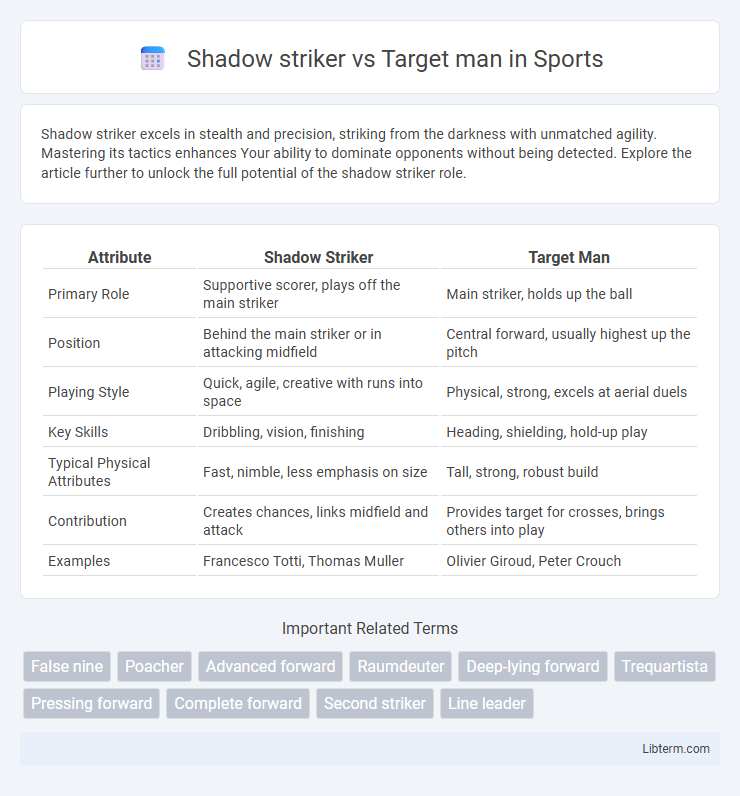Shadow striker excels in stealth and precision, striking from the darkness with unmatched agility. Mastering its tactics enhances Your ability to dominate opponents without being detected. Explore the article further to unlock the full potential of the shadow striker role.
Table of Comparison
| Attribute | Shadow Striker | Target Man |
|---|---|---|
| Primary Role | Supportive scorer, plays off the main striker | Main striker, holds up the ball |
| Position | Behind the main striker or in attacking midfield | Central forward, usually highest up the pitch |
| Playing Style | Quick, agile, creative with runs into space | Physical, strong, excels at aerial duels |
| Key Skills | Dribbling, vision, finishing | Heading, shielding, hold-up play |
| Typical Physical Attributes | Fast, nimble, less emphasis on size | Tall, strong, robust build |
| Contribution | Creates chances, links midfield and attack | Provides target for crosses, brings others into play |
| Examples | Francesco Totti, Thomas Muller | Olivier Giroud, Peter Crouch |
Introduction to Shadow Striker and Target Man Roles
Shadow striker and target man are distinct football roles with specific tactical functions. The shadow striker operates just behind the main striker, exploiting spaces between midfield and defense to create scoring opportunities and apply pressure in the opponent's penalty area. The target man acts as a focal point in attack, using strength and aerial ability to hold up the ball, win headers, and facilitate link-up play for teammates.
Key Attributes of a Shadow Striker
Shadow strikers excel in agility, dribbling, and intelligent off-the-ball movement, enabling them to exploit spaces between opposition defenders and midfielders. Their key attributes include high acceleration, creativity, and vision, allowing seamless link-up play and sudden bursts towards goal. Unlike target men who rely on physicality and aerial prowess, shadow strikers emphasize technical skill and rapid interplay to create scoring opportunities.
Defining Characteristics of a Target Man
A Target Man is characterized by physical strength, aerial ability, and hold-up play, using their body to shield the ball and bring teammates into attacking positions. Unlike a Shadow Striker who thrives in exploiting space behind defenses with pace and movement, the Target Man excels at winning long balls and providing a focal point for attacks. Their primary role involves receiving crosses, engaging in physical duels, and acting as a pivot in the opponent's penalty area.
Tactical Positioning: Shadow Striker vs Target Man
The Shadow Striker operates in the half-spaces, exploiting gaps between opposition defenders with quick, dynamic runs that destabilize defensive lines. Tactical positioning for the Target Man emphasizes holding up play near the opponent's penalty area, using physical presence to shield the ball and create chances for teammates. While the Shadow Striker thrives on fluid movement and positioning slightly deeper to link midfield and attack, the Target Man anchors the striking role by occupying central defenders and facilitating direct, aerial-based attacks.
Role in Team Attacking Strategies
Shadow striker operates just behind the main forward, exploiting spaces to create scoring opportunities through quick runs and sharp passes, enhancing fluidity in team attacking strategies. Target man functions as a focal point in attack, using physical presence to hold up the ball, win aerial duels, and lay off passes, enabling teammates to join the offensive play. Both roles complement each other by balancing direct play and creative movement, optimizing goal-scoring chances within varied tactical setups.
Movement Off the Ball: Differences and Impact
Shadow strikers excel in dynamic off-the-ball movement, frequently dropping into pockets of space and exploiting gaps between opposition defenders to create scoring opportunities. Target men primarily use movement to hold up play and create aerial threats, focusing on positioning to receive long balls rather than constant lateral or diagonal runs. The shadow striker's agile and unpredictable runs increase attacking fluidity, while the target man's stationary presence anchors play and facilitates team support in the final third.
Link-up Play and Involvement in Build-up
The Shadow Striker excels in link-up play by dropping into pockets of space to combine quickly with midfielders and forwards, enhancing fluid attacking patterns and creating scoring opportunities through intelligent movement and sharp passes. In contrast, the Target Man serves as a focal point in build-up play by holding up the ball, winning aerial duels, and distributing effectively to onrushing teammates, facilitating sustained possession and opening channels for advancing attackers. Both roles contribute distinctly to offensive cohesion, with the Shadow Striker driving dynamic interplay and the Target Man anchoring structural buildup.
Goal Scoring Trends: Shadow Striker vs Target Man
Shadow strikers exhibit higher goal-scoring rates from late runs into the box, capitalizing on space between defenders and often finishing with precision shots. Target men rely heavily on aerial duels and hold-up play to create scoring opportunities, registering fewer but more physically contested goals, often from crosses or set pieces. Statistical analyses reveal shadow strikers tend to contribute more goals per 90 minutes due to their mobility and positioning in advanced attacking zones compared to the traditional target man's more static role.
Famous Examples of Shadow Strikers and Target Men
Shadow strikers like Lionel Messi and Thomas Muller excel in exploiting spaces between midfield and defense, combining creativity with goal-scoring ability. Target men such as Peter Crouch and Olivier Giroud are known for their aerial prowess and hold-up play, effectively linking attack and midfield through physical presence. These contrasting roles highlight the tactical diversity in forward positions, with shadow strikers prioritizing agility and movement, while target men emphasize strength and positioning.
Choosing the Right Striker Role for Your Team
Selecting between a shadow striker and a target man depends on your team's tactical needs and playing style. A shadow striker excels in exploiting spaces behind defenses with agility and creativity, ideal for teams emphasizing quick transitions and fluid attacking play. In contrast, a target man offers physical presence and aerial strength, crucial for teams relying on hold-up play, long balls, and set-piece threats.
Shadow striker Infographic

 libterm.com
libterm.com